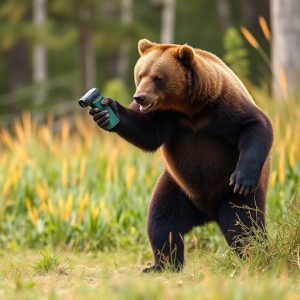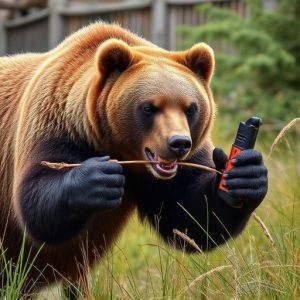Bear Spray Range: Factors, Storage, Safety, and Real-World Applications
Bear spray, effective against aggressive bears due to capsaicin in its formula, requires storage bet…….
Bear spray, effective against aggressive bears due to capsaicin in its formula, requires storage between -20°C and 35°C (or -4°F to 95°F) to maintain potency. Optimal performance is achieved between 10°C to 27°C (50°F to 80°F), with reach influenced by wind, terrain, and user ability. Correct storage, avoiding extreme heat or cold, and proper technique during use are crucial for maximum deterrence, as bear spray isn't foolproof.
“Uncover the power of bear spray as a crucial deterrent in wild encounters. This comprehensive guide explores the science behind this potent tool, delving into its composition, active ingredients, and range effectiveness. We analyze factors like weather conditions and terrain that influence its reach, offering insights for optimal usage. From storage best practices at the proper temperature to real-world success stories, learn how bear spray can enhance safety in outdoor adventures. Discover key safety measures and gain a deeper understanding of its role as a game-changer in preventing aggressive bear interactions.”
- Understanding Bear Spray: Composition and Active Ingredients
- Factors Influencing Bear Spray Range: A Comprehensive Analysis
- Ideal Storage Conditions for Optimal Effectiveness
- Real-World Applications: Success Stories and Case Studies
- Safety Measures and Best Practices for Using Bear Spray
Understanding Bear Spray: Composition and Active Ingredients
Bear spray, also known as bear deterrent or pepper spray specifically designed for wild bears, is a powerful tool for personal safety while hiking, camping, or being in bear country. It’s not just any spray; it’s formulated to create an effective barrier between you and aggressive bears, using capsicum-based ingredients that target the eyes, nose, and mouth, temporarily disorienting them. The composition includes a mix of chemicals designed to be potent at low concentrations, ensuring a safe margin for error in unpredictable bear encounters.
The active ingredients, usually capsaicin, are sensitive to temperature, which is crucial for storage. The proper storage temperature for bear spray is between -20°C and 35°C (or -4°F to 95°F). Beyond these ranges, the spray’s effectiveness can diminish, as capsicum-based deterrents require specific conditions to maintain their potency. Proper storage ensures that when you need it most, your bear spray will be ready and effective, providing a crucial layer of protection during outdoor activities in bear habitats.
Factors Influencing Bear Spray Range: A Comprehensive Analysis
The effectiveness of bear spray as a deterrent is greatly influenced by several factors, including temperature and storage conditions. In cold temperatures, bear spray can freeze, causing the liquid to become thick and less effective. Conversely, high heat can cause the spray to evaporate too quickly, reducing its range and intensity. Thus, maintaining the proper temperature for storage – typically between 50°F to 80°F (10°C to 27°C) – is crucial to ensure optimal performance when needed.
Distance also plays a significant role in bear spray range. While manufacturer guidelines often provide an estimated range of 3 to 4 meters (10 to 13 feet), real-world conditions can vary widely. Factors like wind speed and direction, terrain elevation, and the sprayer’s physical ability can all impact how far the spray reaches. Understanding these variables is essential for users to gauge their effective deterrence zone during bear encounters.
Ideal Storage Conditions for Optimal Effectiveness
To maintain the optimal effectiveness of bear spray, it’s crucial to store it under specific conditions. The ideal temperature for storing bear spray should be between -20°C and 30°C (or -4°F to 86°F). Extreme temperatures can cause the spray to lose its potency, so it’s best to avoid leaving it in direct sunlight or freezing conditions. Additionally, keep the canister away from heat sources like radiators, ovens, or vehicles parked under direct sunlight.
Humidity is another factor to consider. Bear spray should be stored in a dry place, as excess moisture can compromise its integrity. High humidity levels can lead to condensation inside the canister, which may result in reduced pressure and decreased performance when needed. Ensure that the storage area has good ventilation to maintain optimal dryness.
Real-World Applications: Success Stories and Case Studies
In real-world applications, bear spray has proven to be an effective deterrent in numerous success stories and case studies. Outdoor enthusiasts, from hikers to campers, have found that carrying bear spray significantly increases their safety when encountering bears in their natural habitats. These encounters often occur in areas where proper storage of the spray is crucial. The recommended Proper Temperature for Bear Spray Storage, typically between 50°F to 70°F (10°C to 21°C), ensures the spray remains potent and usable.
Case studies have shown that when used correctly, bear spray can deter aggressive bears effectively. In many instances, simply spraying the spray in the air or towards an approaching bear has been enough to make the animal retreat. These success stories highlight not only the spray’s effectiveness but also the importance of knowing how and when to use it. Proper storage and understanding of the spray’s limitations are key factors in ensuring its reliability as a deterrent.
Safety Measures and Best Practices for Using Bear Spray
When it comes to safety measures and best practices for using bear spray, proper storage is key. It’s crucial to keep your bear spray in its original container and store it in a cool, dry place with temperatures between -20°F and 120°F (-29°C and 49°C). Avoid extreme heat or cold, as these conditions can affect the spray’s effectiveness. Always inspect the spray before each use to ensure there are no signs of damage or leakage.
For optimal performance, keep bear spray out of direct sunlight and away from flammable materials. During use, aim for the bear’s face and eyes, maintaining a distance of 20-30 feet (6-9 meters). Never run or turn your back on a bear after spraying; instead, back away slowly while keeping an eye on the bear’s movements. It’s important to remember that bear spray is not a guarantee of safety, and it’s always best to avoid encounters by making noise, traveling in groups, and properly storing food to minimize attractants.
Bear spray, when used correctly, can be an effective deterrent against bear encounters. By understanding its composition, active ingredients, and the factors influencing its range, individuals can make informed decisions while exploring bear country. Ideal storage conditions, including the proper temperature, are crucial for maintaining optimal effectiveness. Real-world applications and safety measures highlight the success of bear spray as a game changer in personal safety during outdoor activities. Adhering to best practices ensures its reliability when facing aggressive bears, providing peace of mind for adventurers and outdoor enthusiasts alike.


